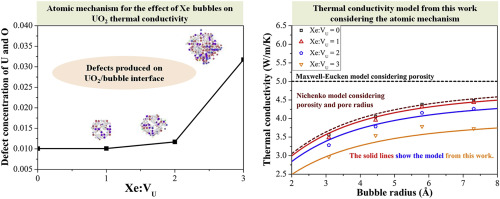Journal of Nuclear Materials ( IF 2.8 ) Pub Date : 2020-02-29 , DOI: 10.1016/j.jnucmat.2020.152080 Xueyan Zhu , Hengfeng Gong , Ya-Fan Zhao , De-Ye Lin , Guomin Han , Tong Liu , Haifeng Song

|
The thermal conductivities of UO2 containing Xe bubbles were investigated using non-equilibrium molecular dynamics (MD) simulations as a function of porosity, bubble radius and the ratio of Xe atoms to U vacancies (Xe:VU). It was found that when the pores are filled with Xe atoms to form bubbles, the porosity and radius of the bubble both increase with the increase in Xe:VU. Based on the equilibrium porosity and bubble radius, a previous model for porous UO2 was used to predict the thermal conductivity. This model predicted only a slight change in the thermal conductivity with Xe:VU, which is induced by the changes in porosity and bubble radius. However, according to MD simulations, the thermal conductivity of UO2 containing Xe bubbles decreases obviously with Xe:VU. This indicates that in addition to porosity and bubble size effects, there exists another mechanism for the degeneration in UO2 thermal conductivity due to the presence of Xe bubbles. MD details revealed that many defects are produced on UO2/bubble interface, the concentration of which increases with Xe:VU. This leads to the increase in interfacial thermal resistance (ITR), thus resulting in the decrease in overall thermal conductivity. Based on the previous model for porous UO2, a model considering the above mechanism was established for UO2 containing Xe bubbles through phenomenological phonon hydrodynamics. In this model, the increase in ITR is reflected by multiplying the thermal-drag force by a correction factor. The proposed model can be implemented in fuel performance codes to improve calculations of fuel thermal conductivity.
中文翻译:

Xe气泡对UO 2导热系数的影响:机理和模型建立
使用非平衡分子动力学(MD)模拟研究了含UO 2的Xe气泡的热导率,它是孔隙率,气泡半径和Xe原子与U空位之比(Xe:V U)的函数。发现当孔隙中充满Xe原子形成气泡时,气泡的孔隙率和半径都随Xe:V U的增加而增加。基于平衡孔隙率和气泡半径,使用多孔UO 2的先前模型来预测热导率。该模型预测,随着Xe:V U的导热率仅发生微小变化,这是由孔隙率和气泡半径的变化引起的。然而,根据MD模拟,含Xe气泡的UO 2的热导率随Xe:V U明显降低。这表明,除了孔隙率和气泡尺寸效应外,由于存在Xe气泡,还存在另一种导致UO 2导热性降低的机理。MD细节显示,在UO 2 /气泡界面上产生许多缺陷,其浓度随着Xe:V U的增加而增加。这导致界面热阻(ITR)的增加,从而导致整体热导率的降低。基于多孔UO 2的先前模型,通过现象学声子流体动力学,建立了考虑上述机理的含Xe气泡的UO 2的模型。在此模型中,ITR的增加是通过将热阻力乘以校正因子来反映的。可以在燃料性能代码中实施提出的模型,以改善燃料导热系数的计算。











































 京公网安备 11010802027423号
京公网安备 11010802027423号